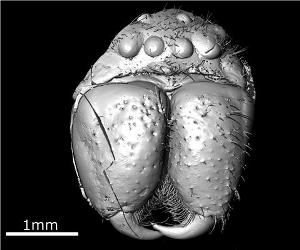Zooming into an Ancient Spider Thanks to New Technology
Advanced Technology Clears up Blurry Amber Revealing Treasures Within
Researchers at the University of Manchester (England), have used advanced computer imaging techniques combined with three-dimensional X-ray scanning technology to reveal the face and details of an ancient spider that lived during the Palaeogene Period, some forty-nine million years ago.
Ancient Spider
The spider, known as a Huntsman Spider (Sparassidae), was preserved in tree resin that solidified and formed amber, trapping this little arthropod and enabling scientists nearly fifty million years later to study it in fine detail. Amber is a sticky, resin produced by certain trees, especially conifers. Insects and other organisms become trapped in this resin and fossilised when it hardens into amber.
Unfortunately, over time in the presence of oxygen the amber can become opaque, thus obscuring the tiny creatures that it might contain. The use of sophisticated X-ray computer tomography enables scientists to lift the veil on the hidden treasures that amber might contain, enabling them to build up amazingly detailed pictures of pollen, plant debris and small creatures that were trapped and preserved.
This is not the first time that spider fossils have been revealed by close examination of amber. Back in 2009 we reported on the discovery of the remains of spider’s silk threads being preserved in a lump of amber found in the UK that dated from the Cretaceous Period.
To read this article: World’s Oldest Spider’s Web Discovered.
Scientists from Manchester University, working with their colleagues from the Berlin Natural History Museum explored the amber nodule to reveal the facial features of this ancient spider. Their work is being reported in the scientific journal “Naturwissenschaften”. This team have demonstrated how opaque amber nodules can yield important scientific data, when X-ray computer tomography and other sophisticated research techniques are applied.
Commenting on the study, Dr David Penney, of Manchester University’s Faculty of Life Sciences stated:
“More than 1,000 species of fossil spider have been described, many of them from amber. The best-known source is Baltic amber, which is about 49 million years old and that has been actively studied for more than 150 years.”
He went onto add:
“Indeed, some of the first fossil spiders to be described back in 1854 were from the historically significant collection of Georg Karl Berendt, which is held in the Berlin Natural History museum. A problem here is that these old, historical amber pieces have reacted with oxygen over time and are now often dark or cracked, making it hard to see the animal specimens inside.”
The Manchester University team were surprised to find the oldest example known of a Huntsman spider preserved in amber. These strong and quick spiders would have been unlikely candidates to get caught in slow moving tree resin – but apparently one spider forty-nine million years ago may have been unlucky enough to have been caught. To test the theory that the spider’s remains were indeed that of a Huntsman, an international team of experts in the fields of fossils and living spiders, and in modern techniques of computer analysis decided to re-study Georg Berendt’s original specimen to determine what it was.
The Face of the Forty-Nine Million Year Old Huntsman

Picture credit: Manchester University
Dr Penny said:
“The results were surprising. Computed tomography produced three-dimensional images and movies of astounding quality, which allowed us to compare the finest details of the amber fossil with similar-looking living spiders. We were able to show that the fossil is unquestionably a Huntsman spider and belongs to a genus called Eusparassus, which lives in the tropics and also arid regions of southern Europe today, but evidently lived in central Europe fifty million years ago.”
Professor Philip Withers of Manchester University concluded:
“Normally such fossils are really hard to detect because the contrast against the amber is low but with phase contrast imaging the spiders really jump out at you in three-dimensions. Usually you have to go to a synchrotron X-ray facility to get good phase contrast, but we can get excellent phase contrast in the lab. This is really exciting because it opens up the embedded fossil archive not just in ambers.”
For models and replicas of ancient invertebrates from the Palaeozoic and the Mesozoic: CollectA Prehistoric Life Models and Figures.

